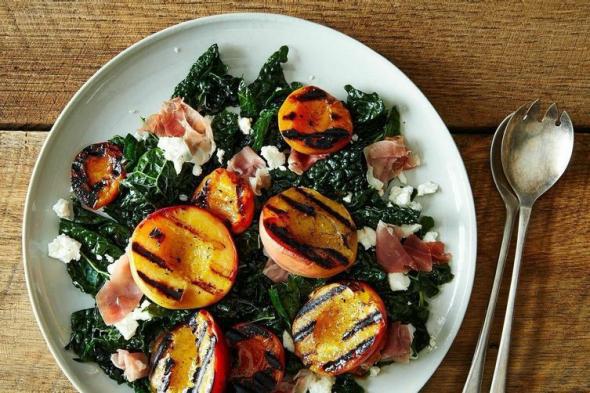This post originally appeared on Food52.
Tamar Haspel recently published an article in the Washington Post arguing that salad is overrated. And sure, salad gets a lot of attention—but Haspel calls salad overrated not because of the hype but rather because, she argues, it’s nutrient-poor, expensive, and a tax on our food system.
Hold that thought. To me and my colleagues at Food52, a salad can be so many things—not just a bowl of lettuce—so how could this be true? We have a salad confusion on our hands. Here’s where the article steers us wrong:
1. Salad is lettuce.
What is a “salad vegetable”? There’s no definition of what a salad is, or the type of salads that are being discussed—in fact, the article seems to equate lettuce with salad. My salad today could’ve been any number of things (it’s summer, so there’s a lot to play with), but it had zucchini, grains, and cheese—no lettuce. Saying that salad has a lettuce problem is like saying pasta has a cream sauce problem. Not all pastas have cream sauce, and not all salads have lettuce (here are 318 examples).
Haspel does define some of these “salad ingredients”: “Four of the five lowest-ranking vegetables (by serving size) [on the nutrient quality index] are salad ingredients: cucumbers, radishes, iceberg lettuce and celery. (The fifth is eggplant.)” I’ll get to the nutrition part in a second, but I’m not sure why these four ingredients are siloed as “salad ingredients”—and eggplant is left out—when you can make a salad with eggplant; a soup or two, drink, or taco with cucumber; and a soup, pizza, sauté, braise, or pickle with radishes. Celery is the start of so many dishes, and lettuce doesn’t always mean salad.
2. Salad fools dieters into making bad choices.
Salad, you’re so sneaky! Wrong. Salad isn’t fooling anyone—misinformation about ingredients and their nutritional value is. So what do we do about this? The solution to the misinformation about salad/lettuce isn’t to eliminate salad/lettuce or the consumption of salad/lettuce entirely, as this article purports. Rather, it’s to know what you’re eating.
3. Salad ingredients are low in nutrient quality.
Yes, I can make a salad with lettuce (which the article says is full of water, not nutrients), fried chicken, croutons, and mayo dressing, and it might not be great for me nutritionally. But I can also make a burger out of black beans and quinoa and it can be really good for me. Salad is a type of food, like a burger; neither are ingredients with innate nutritional values.
4. Lettuce has unfortunate repercussions on our food supply.
Haspel mentions that lettuce is the top source of food waste, “becoming more than 1 billion pounds of uneaten salad” every year, but she doesn’t explain why or whether that 1 billion refers to lettuce leaves, pre-made salads, and other salad ingredients. Moreover, the study credited with this information “did not include mixtures of fresh fruit or vegetables (e.g., fruit salad, platters of vegetable sticks, and pre-packaged salads made from both leafy greens and fruit) in their calculations of quantitative data…).”
Bottom line: We’re a little iffy on how salad is affecting our food supply. I’m on board for eliminating food waste, but it’s unclear how eliminating salad will fix that. To eliminate food waste, you have to go to the source (to the ingredients), and you have to make changes in your own choices.
5. Salad is expensive.
Haspel writes: “The corollary to the nutrition problem is the expense problem. The makings of a green salad—say, a head of lettuce, a cucumber and a bunch of radishes—cost about $3 at my supermarket. For that, I could buy more than two pounds of broccoli, sweet potatoes or just about any frozen vegetable going, any of which would make for a much more nutritious side dish to my roast chicken.”
I have an idea! (It’s not that novel; don’t get too excited.) Make a broccoli and sweet potato salad—that sounds so good (and nutritious), and your salad is no longer an “expense problem.”
Salad doesn’t have to be expensive or low in nutrient value or a drain on our planet—because salads can have all different types of ingredients. I’d define a salad as any combination of raw and/or cooked ingredients—at least one of which is typically a vegetable—that’s been doused with some sort of dressing. The salad that seems to be standing in for all salads in this article—a lettuce salad with some anemic vegetables—is just one type, and I think we’ve moved beyond this definition.
In the end, if Haspel had changed every mention of “salad” to “lettuce,” I might not have written too many words on the topic. But I don’t support fearmongering that what we’re eating—salad—is “overrated,” hurtful (“save the planet, skip the salad”), and “a resource-hungry luxury” when it’s not, when it can’t be. Saying so oversimplifies the situation and won’t help us fix the problems Haspel cares so much about. Yes, my colleagues and I want to make good food choices, too—for ourselves and for our friends, family, pets, and planet. But salad isn’t going to get us there. (Maybe soup? Just kidding.)
More from Food52:
A Genius Make-Ahead Salad for Work Lunches, Picnics, and Potlucks
20 Essential Kitchen Hacks
5 Money-Saving Kitchen Hacks
How to Keep an Avocado From Browning
8 Ways to Eat Lunch Like You Work at Google
How to Spend Less Money on Your Favorite Ingredients
